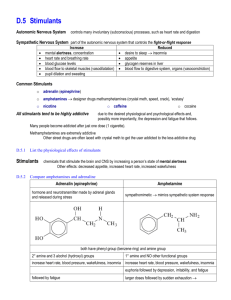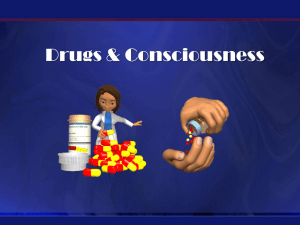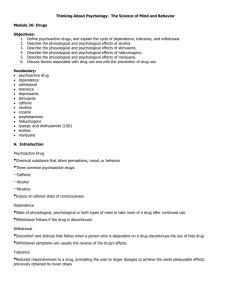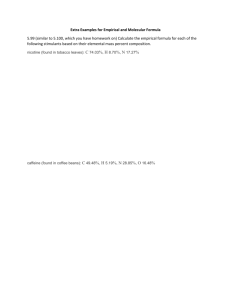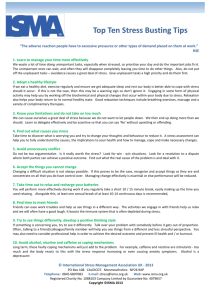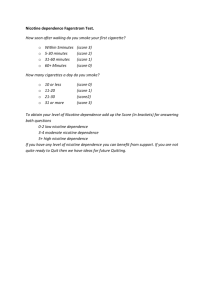Drugs and Consciousness
advertisement
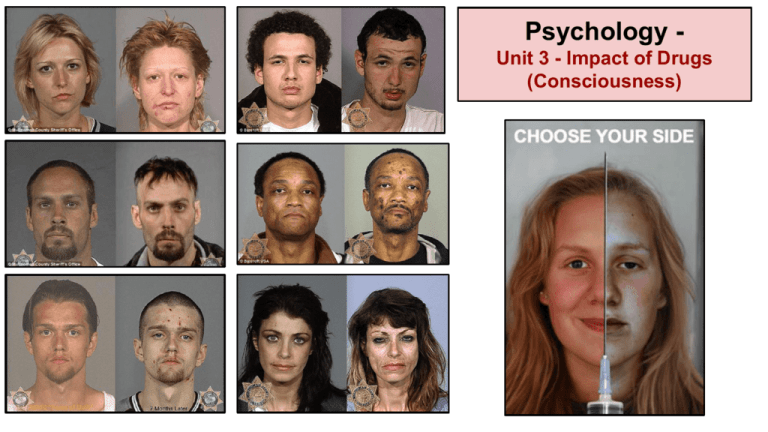
Psychology Unit 3 - Impact of Drugs (Consciousness) Psychoactive Drugs Drugs: A chemical substance that can alter perception & mood. They impact consciousness They break the blood-brain barrier. Dependence & Addiction: Continued use of a psychoactive drug produces tolerance. With repeated exposure to a drug, the drug’s effect lessens. Thus it takes bigger doses to get the desired effect. Psychoactive Drugs Withdrawal: Upon stop taking a drug (after addiction) users may experience undesirable effects of withdrawal. Dependence: Absence of drug may lead to feelings of physical pain, intense cravings (physical dependence) & negative emotions (psychological dependence). Addiction: Craving for a chemical substance despite its adverse consequences ★ Corrupting: Drugs quickly corrupt ★ Support: Cannot be overcome voluntarily ★ Misconceptions: Not different than repetitive pleasure seeking behavior, gambling, food, & internet Depressants: Drugs that reduce neural activity & slow body functions 1. Alcohol 2. Barbiturates 3. Opiates 1. Alcohol In low doses - relaxes drinker by slowing down the sympathetic nervous system (lowering inhibitions & judgements) In high doses - reactions slow, speech slurs, & skilled performance deteriorates Also affects memory by disrupting the processing of recent events into long-term memory, reduces self-awareness, & focuses one’s attention on immediate situation rather than future consequences. How does the body react to alcohol? Generally it takes about 1 hr to metabolize the alcohol in 1 drink Women metabolize alcohol more slowly than men If a woman & man of the same weight consume the same amount of alcohol, the woman would be more intoxicated than man due to the way their bodies are composed. Men have more muscle which speeds up the metabolizing of the alcohol. Depressants: Drugs that reduce neural activity & slow body functions 1. Alcohol 2. Barbiturates 3. Opiates 2. Barbiturates: drugs that mimic the effects of alcohol depress CNS activity & in larger doses, can lead to impaired memory & judgement Examples: Nembutal, Seconal, & Amytal Depressants: Drugs that reduce neural activity & slow body functions 1. Alcohol 2. Barbiturates 3. Opiates 3. Opiates: Opium & its derivatives (morphine & heroin) depress neural activity, temporarily lessening pain & anxiety. They are highly addictive. HEROIN User gets a short lived feeling of blissful pleasure (3-5 hrs), followed by craving for another fix, the need for progressively larger doses, & physical withdrawal symptoms. Methadone - treatment used when trying to combat a heroin addiction. At the higher dosages given, the individual does not get ‘high’ yet it is enough to reduce the intense physical cravings. However, people can become addicted to Methadone. Stimulants: Drugs that excite neural activity & speed-up body functions 1. Caffeine 2. Nicotine 3. Cocaine 4. Ecstasy 5. Amphetamines 6. Methamphetamines 1. Caffeine & Nicotine: Caffeine & nicotine increase heart and breathing rates, & other autonomic functions to provide energy. Caffeine: Found in coffee, tea, soda, chocolate & many over-the-counter meds ★ Most people use caffeine daily. Considered to be the most widely-used psychoactive drug in the world. ★ Increases attentiveness & improves mood by mimicking adenosine (a neurotransmitter) ★ Is physically addictive: individuals can experience withdrawal symptoms (usually from a few days up to a week will have headaches, irritability, drowsytiredness) ★ At high doses - can produce anxiety, restlessness, insomnia & increased heart rate. Recommended amount per day is 250 milligrams Coffee (8 oz) 85 - 250 mgs Tea (8 oz) 16 - 60 mgs Soft Drink (12 oz) 35-70 mgs Stimulants: Drugs that excite neural activity & speed-up body functions 2. Caffeine & Nicotine: Caffeine & nicotine increase heart and breathing rates, & other autonomic functions to provide energy. ★ ★ ★ ★ A synapse is the site where two neurons communicate. The presynaptic neuron releases a neurotransmitter, which binds to receptors on the postsynaptic cell. This allows signals to be transmitted from neuron to neuron in the brain. Nicotine leads to a burst of receptor activity. leads to increased release of acetylcholine from the neurons, calling your body and brain to action, This is the wake-up call that many smokers use to re-energize themselves throughout the day. Nicotine improves your reaction time and your ability to pay attention, making you feel like you can work better. Nicotine also increases the level of other neurotransmitters & chemicals that modulate how your brain works. For example, endorphins are produced. Endorphins can lead to feelings of euphoria also. If you're familiar with the runner's high that kicks in during a rigorous race, you've experienced the "endorphin rush." This outpouring of chemicals gives you a mental edge to finish the race while temporarily masking the nagging pains you might otherwise feel. Stimulants: Drugs that excite neural activity & speed-up body functions 2. Nicotine: Why do people smoke? 1. Socially rewarding 2. A result of genetic factors 3. Nicotine takes away unpleasant cravings (negative reinforcement) by triggering epinephrine, norepinephrine, dopamine, & endorphins. 4. Nicotine itself is rewarding (positive reinforcement). Nicotine kills nearly 5 million people worldwide each year (out of 1.3 billion smokers) Smoking delivers its hit of nicotine within 7 seconds. Stimulants: Drugs that excite neural activity & speed-up body functions 3. Cocaine: Illegal stimulant derived from coca tree. Derivatives (novocaine) are used today as anesthetics. Originally part of Coca-Cola’s formula in 1888, was replaced in 1903 by caffeine. Yet coca leaves, with cocaine extracted for medical purposes, are still used today as flavoring in some cola drinks. When inhaled/’snorted’ - reaches the brain in minutes. ★ Produces intense euphoria ★ Mental alertness ★ Self-confidence ★ Typically lasts for several minutes (but 10-30 min. if someone is a binge user) Cocaine blocks the reuptake of dopamine. The brain is flooded with dopamine-produced pleasure sensations. Stimulants: Drugs that excite neural activity & speed-up body functions 4. Ecstasy (MDMA) - a stimulant & mild hallucinogen Increases empathy, peacefulness & the person ‘feels’ calm or relaxed, yet they also seem to have an unending supply of energy. ★ ★ ★ ★ Popular ‘club drug’ Immediate dehydrating effects, combined with the prolonged physical activity (like dancing) causes the person to risk severe overheating, increased blood pressure & death Decline in memory & performance on IQ tests They believe MDMA causes long-term serotonin changes in the brain, leading to reduced serotonin levels & increased risk of depressed mood. Stimulants: Drugs that excite neural activity & speed-up body functions 5. Amphetamines: ‘speed’ or ‘uppers’ - Suppress appetite & were once prescribed as diet pills. Not prescribed any longer because of tolerance to its appetite suppressant effects occurs quickly, meaning the individual has to have more & more of the drug to main effects. Also increase concentration & reduce fatigue. Can increase anxiety & irritability. 6. Methamphetamines (‘crystal meth’) Illegal drug manufactured in street labs that is either smoked or injected. As with all amphetamines, after using for awhile one ‘crashes’ & exhibits withdrawal symptoms of fatigue, deep sleep, intense mental depression & increased appetite. Incredibly addictive! Over time it appears to reduce the baseline dopamine levels leaving the users with permanently depressed functioning. Hallucinogens: psychedelic (mind-manifesting) drugs that distort perceptions & evoke sensory images in the absence of sensory input. LSD (Lysergic Acid Diethylamide) “ACID” - one of the most powerful drugs known - only takes 1-millionth of an ounce to produce mind altering effects. 1st synthesized from rye fungus by Swiss chemist in late 1930s (Hofmann accidentally ingested a small amount of the substance) ★ ★ ★ Trip lasts 6-14 hours - effects vary greatly Visual distortions & hallucinations Emotions are very intense & unstable & impaired thought Bad Trips: terrifying & users are in a state of panic. Feel as if they have gone mad & will never return to normal. Some have ended tragically in accidents, death, or suicide. Flashbacks - The substance is forever stored inside the synapses of your spine. It is very possible to have sudden and w/o warning recurring ‘trips.’ Marijuana & LSD Not physically addictive But, HIGHLY psychologically addictive Hallucinogens: psychedelic (mind-manifesting) drugs that distort perceptions & evoke sensory images in the absence of sensory input. Marijuana: Produces feeling of elation, promotes relaxation, relieves inhibitions, relieves anxiety, & increases sensitivity to sights, sounds, & touch. Can cause a sense of time distortion. THC (tetrahydrocannabinol) - ingredient that produces the ‘high’ & remains in body long after use. 10% remains in system after 7 weeks Effects: ★ Impairs attention/coordination ★ Slows reaction time ★ Interferes with concentration ★ logical thinking slows ★ Difficulty forming new memories ★ & Ability to hold in mind what was said Chronic use associated with loss of motivation & general apathy. Causes respiratory damage faster than smoking cigarettes & heavy use/abuse affects the reproductive system, esp. in males. 1945 - Narcotic Education Foundation of America Influences on Drug Use: Biological Physiological Social-Cultural Biological - Addictive gene can give someone a tendency for addiction, but also for needing a higher amount of the drug for the same impact. Physiological - Stress, additional psychological disorders can bring on the need to ‘medicate’ through drugs in an attempt to reduce the impact. Social-Cultural - The availability of drugs has a massive impact on the chances of use. An urban environment & high population center can influence availability. Peer pressure and impact of ‘friends.’
